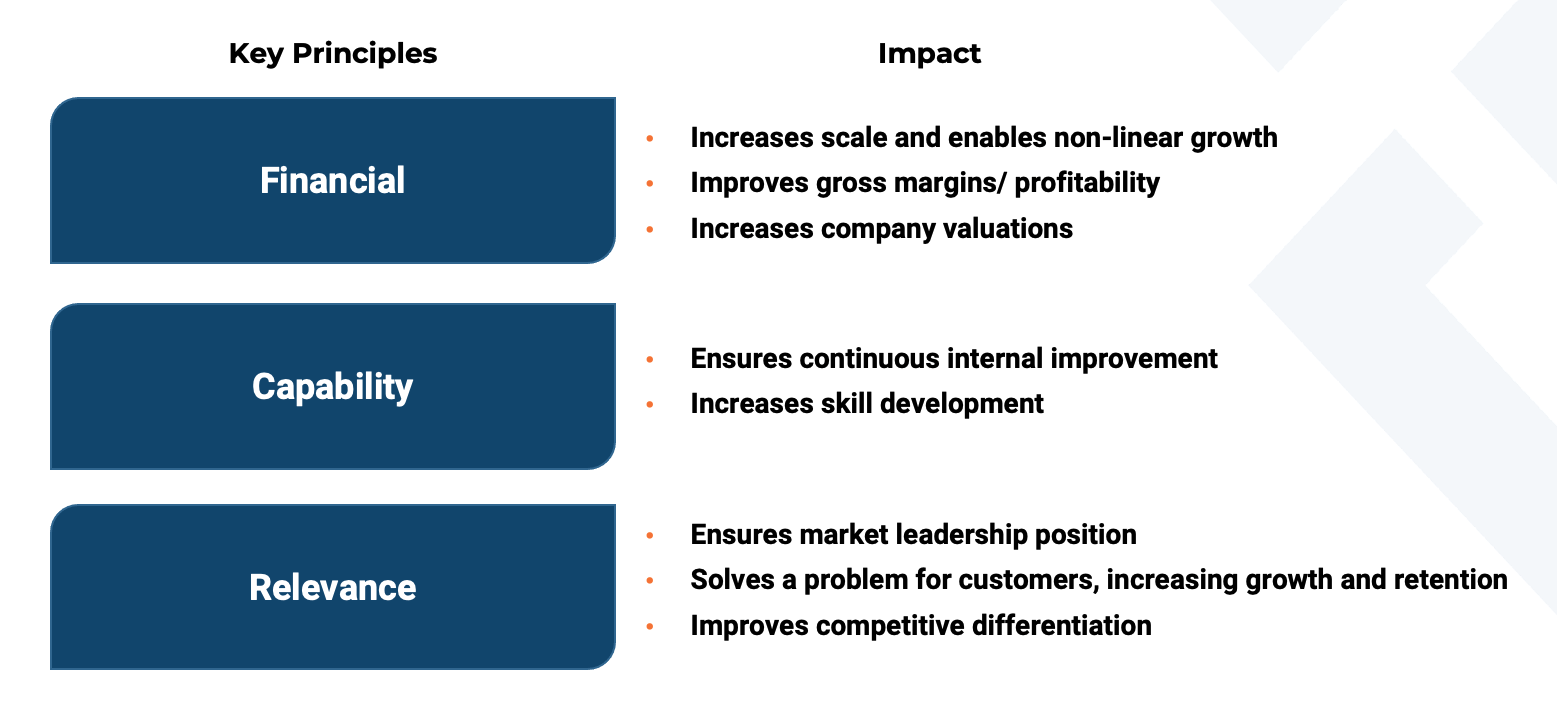The Best Product Visions are Aspirational and Concrete

Productizing services firms can use well-crafted vision statements to galvanize support for profound organizational transformation.
Client: “Our product vision is to generate $20m in standalone product revenue in three years that has 45% net margins.”
Me: “That’s a good goal. What is your vision?”
When an organization is struggling to gain buy-in for the product strategy, it is often because the leaders have not created or communicated their vision for the strategy.
A vision is not the same thing as a goal. Product strategies should have goals, but those goals should reflect the values wrapped up in a bigger picture understanding of what the product itself will do for customers, first, then the business itself. For example, “We will help mid-size companies protect their intellectual property using the same tactics that previously only the largest companies could afford.”
Pursuing a product strategy without a compelling, realistic vision statement can be extremely painful. One colleague recently offered this advice:
“You need to have some clarity around what your productization ambition is. If you are a non-digital business, you can get better and smarter if you incrementally learn to deliver digital products and services differently. But if you are a non-digital business seeking to disrupt the market, then you need to learn much more rapidly. Either way, the vision needs to be clearly articulated, and buy-in achieved.”
This advice was hard won: this consulting company had made intensive internal changes to go to market quickly with tech-enabled products but hadn’t spent time explaining why these changes were being made, at this pace. This is, of course, what a vision is: a vision statement describes why we are doing something, rather than simply what we are doing.
Because employees at this organization didn’t understand the reasoning behind the current product strategy, they were disenfranchised. Once leadership articulated the product vision–describing precisely how the product strategy would impact customers, employees, and the business as a whole–the pace of productization increased as resistance began to dissolve.
This organization learned that a clear, compelling, and realistic vision statement is the cornerstone of a productization strategy, and it is necessary for both making savvy business decisions and facilitating change.
In this article, I describe:
- How clear, compelling, and realistic vision statements enable change by protecting against biases and fears.
- How B2B services organizations can best write a motivating vision statement for their productization strategy.
Clear Vision Statements Lend Objectivity to Decision Making
A clearly written vision statement should guide the prioritization of ideas and serve as the foundation of the strategic product portfolio roadmap, or the products offered, the problems they solve for clients, and wherein the clients’ journey each product fits.
For example, an organization may have a strong, responsive technology team and no shortage of product ideas. But if leadership hasn’t outlined the purpose of pursuing a productization strategy, as well as specific, measurable goals of the product strategy, they will struggle to make objective decisions about which ideas to prioritize and which product ideas to put in the backlog. And biases can quickly obscure good ideas.
I have seen clients exhibit a variety of product prioritization biases, including:
“Recency bias,” creating a product to meet the most recent client’s needs, not based on the best market opportunity or overall strategy.
“The Halo Effect,” which can allow the positive impression of a person to lead us to see something related in the same positive light. This can look like following the lead of an admired executive, despite what market data shows.
“Safety bias,” creating a product where an existing client has agreed to partially fund and/or pilot to protect loss instead of seeking the largest market opportunity gain.
A clear vision helps leaders protect against decision-making biases and make decisions that align better with strategy. A vision for your productization strategy also guides other decisions such as organizational structure, governance processes, job descriptions, budgets, and staffing. None of these decisions can be made well if not underwritten by clearly defined objectives.
Compelling Vision Statements = Fearless Change
Consider this scenario: As happens in many companies, the leadership of a marketing firm is struggling to generate organizational urgency for the product strategy. Lack of urgency is a major barrier to organizations that are considering creating tech-enabled products or productized services. This firm’s top-line revenue growth is strong, and the team doesn’t understand why now is the time to launch a product strategy.
The fix: leaders revisited their vision statement and aimed to make it more compelling for their employees. To be compelling, vision statements need to articulate the big-picture impact that product will have on customers and employees alike.
Casting a customer-centric vision statement is compelling because it helps remind employees of their work's impact on the world. R. Dutt, in his book Radical Product Thinking, puts it this way:
“Your product is your mechanism to create the change you envision for
your users….Your vision must resonate with the people whose lives you want to impact since you want them alongside you on this journey. This is why you should steer away from vision statements like ‘To be a leader in our industry—your customers don’t care who the leader is! They just care that they have a product that solves their problem.” (44-47)
Customer-centric vision statements are a well-established change management tool, as Amy Edmonson writes in her seminal work The Fearless Organization: “Leaders who remind people of why what they do matters–for customers, for the world–help create the energy that leads them through challenging moments” (166). Will your products reduce burnout? Will it create kinder work environments? Will it ensure that people get paid on time? Whatever the company hopes to achieve, ensure that the vision is focused on benefits to customers.
Research shows that putting people in touch with the impact of their work gives employees the courage to confront “interpersonal risks”--fear of rejection, failure, being wrong–as well as to approach work with more creativity (Edmonson 167).
I would add that the most compelling product vision statements for organizations new to tech-enabled productization should also make it personal, by spelling out a strategy’s tangible wins for employees.
Will digital products make their jobs easier through automation and standardization? Will they improve work-life balance? Will it Give them more autonomy? Leaders should consider these benefits, and make them explicit. When employees see exactly how the product strategy will impact their lives for the better, it is easier for teams to accept change in their day-to-day work.
Realistic Vision Statements Make a Strong Business Case
Both Dutt and Edmondson caution against including business-oriented language and metrics in an organization’s vision statement, instead encouraging readers to focus on the big picture. But in my experience, organizations new to tech-enabled productizations need to write a strong business case into their vision statements because the extent of change for these firms is greater than that of product-led or product-native organizations. If a vision statement doesn’t make a realistic business case, resistance to change will persist, no matter how clear or compelling it may be.
Realistic vision statements should include the productization strategy's key business principles and objectives. Here are some sample principles by category:

For example; while this vision statement is not very customer or employee-centric, it does articulate the business objective:
“We will invest in new product development into adjacent and complementary areas with innovative, tech-driven offerings to drive future growth and shareholder value.”
The next step is to get specific about identifying outcomes and key metrics. What are the outcomes for the business based on your key principles?
For example, if you’re striving to be a center of innovation for a product, you may want outcomes like this:
- Successfully transition 30% of existing revenue into productized revenue in the next 3-5 years.
- Organically launch 2-3 tech-enabled products in the next 4 years, earning $5M in gross revenue.
- Improve equity at 5,000 clients by 2024.
Whatever timeframe you choose, create regular measures of progress to ensure you stay on track. If an objective is to transition 30% of revenue into “productized” revenue in 3-5 years, what metric should be hit in 6 months? In one year? Using an OKR framework, which stands for “Objectives and Key Results,” can be a useful tool for tying these objectives to measurements.
Language Matters
Ultimately, clear, compelling, and realistic vision statements need to be written for the stakeholders you seek to bring on board. Use language that everyone can understand and avoid jargon and acronyms. This is easier said than done, especially when including a business case in the product vision statement.
Need help getting started? Try filling in this template, which includes space for everything that a new-to-productization vision statement needs:
We will change the way [target customer segment] solves {urgent and expensive customer problem] through the development of [tech-enabled/standardized products or services or solutions]. We will [overarching business goal] by [reaching specific targets].
For example,
We will change the way hospitals and healthcare systems make real-estate decisions by developing new data products to offer alongside our design services. We will grow revenue and improve margins by selling $20m of data products that have 40% net margins in the next three years.
OR
We will help US-based companies develop more inclusive leaders by scaling our programs using technology. We will both improve margins and improve employee satisfaction by shifting our revenue to 80% standardized and tech-enabled programming by 2026.
OR
“We will help mid-size companies protect their intellectual property using the same tactics that previously only the largest companies could afford by creating a suite of high-quality do-it-yourself IP protection support tools. We will grow revenue by selling $30m in products to this new market segment by 2025.”
We always work with leaders to help ideate clear, compelling, and realistic product vision statements. Usually, making changes to the product vision means that the product strategy will change too. This is normal– and necessary! Contact Nicole to set a time to discuss your existing vision statement, and to consider the changes it may bring to your business.
